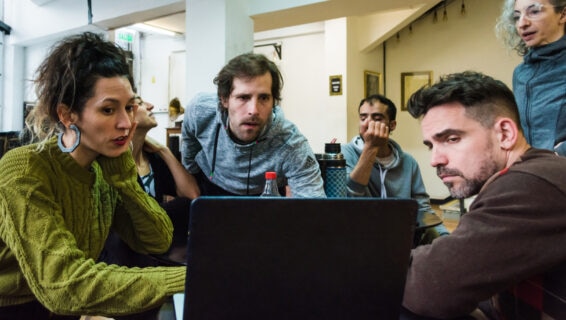
How to conduct a second interview
Table of Contents
- The goal of second interviews
- Preparing for a second interview
- Conducting a second interview

How to Interview Candidates
After narrowing down your candidates in the initial recruitment stage, the second interview demands a more targeted and thorough approach.
This stage is about delving deeper into the candidate’s skills, experience, and values to determine if they align with the specific needs of the role and your organisation’s culture. It’s also an opportunity to evaluate their potential as a team member and assess whether their career goals resonate with your organisation’s vision.
A well-conducted second interview is a critical step in the hiring process, often making the difference between securing the right talent or making a misstep.
In this article, we’ll explore strategies for conducting successful second interviews, offering proven techniques and practical tips to help you make confident, informed hiring decisions.
The goal of second interviews
While first-round interviews are typically concise and focused on reducing a large candidate pool, the second interview serves as a deeper dive into the remaining applicants.
At this stage, the goal is to refine your selection further, narrowing it down to a small number—or even a single standout candidate—ready for a potential job offer.
A second interview should thoroughly assess the candidate’s alignment with the competencies required for the role, explore their potential behaviours in the workplace, and evaluate how well they fit your organisation’s culture. Depending on your organisation’s size and recruitment structure, this interview might be just one step in a multi-phase process or the critical discussion leading directly to a hiring decision.
Either way, by the end of this stage, you should have a solid understanding of your candidates and confidence in moving forward with your choices.
Preparing for a second interview
As a hiring manager or recruiter, you’ll want to be well-prepared for the second interview so that both your organisation and the candidates involved have a productive and worthwhile experience.
Here are some of the key steps to take in preparation.
1. Decide on the format
When planning your second interview, choose the format that best suits your organisation and industry. This might involve remote video interviews or in-person meetings, depending on the logistical needs and preferences of both candidate and interviewer.
Additionally, consider the number of interviewers to include. Panel interviews can be very useful at this stage, allowing for multiple perspectives, helping to reduce bias, and enabling collaborative decision-making through shared insights.
Your panel might consist of another manager, a colleague who would work closely with the candidate, or an HR professional. In any case, be sure to provide all panellists with the necessary candidate details beforehand so they are well-prepared and informed. Decide in advance who will take the lead during the interview and assign specific tasks or areas of focus to each panellist to ensure the process is structured and comprehensive.
2. Plan your questions
While first interviews often provide a general overview of a candidate, second interviews demand a more structured and detailed approach. This stage is your opportunity to dig deeper and carefully assess whether the candidate is the right fit for the role. Proper planning is essential to ensure your questions are focused, relevant, and insightful.
One of the most effective approaches is to use competency-based interviewing, which targets the core skills and abilities required for the position. These questions encourage candidates to share specific examples from their past experiences, demonstrating how they’ve applied those competencies in real-life situations.
Competency-based questions typically start with prompts like, “Tell me about a time when…” or “Give me an example of when…”. They are sometimes referred to as behavioural questions because they provide valuable insights into how candidates have tackled challenges in the past and how they might respond to similar situations in the future.
For examples of these types of questions, see the following section for inspiration and best practices.
3. Prepare the candidates
A successful second interview begins with clear candidate communication. When inviting applicants to this stage of the interview process, provide a detailed explanation of what it will involve.
Let them know the format, who will be attending, and any materials they need to bring, such as portfolios, certificates, or completed tasks that demonstrate their abilities. This preparation helps candidates feel more at ease and ensures they are able to showcase their skills effectively.
For consistency and ease of comparison, aim to schedule all second-round interviews within a short time frame. Ideally, conduct all interviews on the same day or, if necessary, on consecutive days.
This approach reduces the risk of forgetting key details and ensures a fair and efficient evaluation process, making it easier to assess candidates and make well-informed hiring decisions.
Conducting a second interview
Once you have your questions prepared, your candidates invited and your interview panel (if you choose to have one) organised, it’s time to do the second interview.
Follow these top-second interview tips to make sure it all goes smoothly, and you can be confident in your final decision.
Put the candidate at ease
The main purpose of a second interview is to get a better impression of a potential candidate’s personality and skills.
For this reason, you need to try and make the interviewee as comfortable and relaxed as possible. This will make them feel at ease which will allow them to give the best account of themselves. Simple things like enquiring about their journey or offering them a drink can help create a more relaxed feel. Diving straight into an interview can seem more like an interrogation, and this gives off the wrong signals.
Once introductions have been made and they are settled, you can give them a quick rundown of how the interview is going to work and tell them they will have time to ask any questions at the end.
Key questions to ask in a second interview
By this stage, you should have a well-structured list of questions designed to evaluate whether the candidate possesses the skills, competencies, experience, and attitude required for the role. Competency-based interview questions are particularly effective, as they focus on past experiences to predict future behaviour.
Here are some examples of competency-based questions that work well across industries and job roles:
- “Tell me about a time you had to deal with a difficult person or customer.”
- “Describe a situation where you had to meet a tight deadline.”
- “Give me an example of when you showed leadership skills.”
- “Tell me about a time you made a mistake at work.”
- “Describe a project where you had to collaborate with different departments.”
- “Give an example of a time you had to adapt to a significant change.”
- “Tell me about a time you went above and beyond what was required.”
You may also want to include additional types of questions, such as those exploring cultural fit, to determine whether the candidate aligns with your organisation’s values and environment. Hypothetical questions can also be useful to assess problem-solving abilities and see how candidates think on their feet.
Ensuring a balance of question types will help you gain a comprehensive understanding of the candidate’s suitability for the role.
Take interview notes
Taking detailed notes during the interview and scoring candidates’ answers against your pre-determined system is crucial for achieving an objective and fair assessment. Notes provide a reliable reference point when comparing candidates and ensure consistency in your evaluation and feedback processes.
If you are conducting a panel interview, consider assigning one panel member to focus solely on notetaking. This allows the other interviewers to engage fully with the candidate and observe their responses in real-time. Accurate, unbiased notes will be especially valuable when reviewing candidates later or making decisions as a team.
Confirm practicalities
While the main focus of a second interview is to assess the candidate’s suitability for the role, it’s also essential to clarify key practical details before progressing to a job offer.
Ensure to cover these critical points:
- What are their salary expectations?
- When would they be available to start?
- If they’re currently employed, how long is their notice period?
- Can they provide the required references?
- Are they comfortable with the proposed working arrangements, including contracted hours and flexibility (e.g., remote or hybrid working)?
Ensure you cover these critical points:
Addressing these questions helps to avoid potential misunderstandings later and ensures you and the candidate are aligned on the role’s key terms and conditions.
Have an open conversation
Second interviews often feel more conversational, offering a chance for mutual engagement rather than the one-sided questioning typical of first interviews.
Use this opportunity to ensure candidates can ask their own questions about your organisation, team dynamics, and the role itself. Answer these questions thoroughly – this is your chance to not only assess the candidate further but also to showcase why your organisation is a great place to work.
Discussing aspects such as company culture, team structure, and collaboration methods helps the candidate gain a clearer understanding of how the business operates. This dialogue is crucial for building rapport and can significantly enhance your ability to attract top talent.
Outline the next steps
It’s important to set clear expectations for the candidate after the second interview.
Inform them if there are additional interviews scheduled and provide a timeline for when they can expect to hear back with an update. Writing up feedback immediately after each interview helps to maintain clarity and ensures you can provide detailed, constructive feedback when necessary.
Let the candidate know that they are welcome to reach out via email with any questions they might have while they wait for your response. Keeping communication open helps maintain a positive candidate experience, even if you decide not to proceed with their application.
Keep the candidate updated
It’s essential to keep candidates informed throughout the recruitment process to maintain their interest and engagement, as regular communication helps build a positive candidate experience and fosters trust. If candidates don’t feel adequately updated, they may lose confidence in your process, potentially accepting offers from other employers.
If there are any delays or changes to the timeline, make sure to notify the candidate as soon as possible, explaining the reason for the hold-up. By being transparent and responsive, you ensure the candidate remains engaged and reassured that they are still being considered for the role.
Additionally, providing updates helps to manage expectations and allows the candidate to plan accordingly, increasing the likelihood of securing top talent.
Receive the latest recruitment resources and
advice to boost your hiring
By providing us with your details you agree to our privacy policy and for us to keep you updated with the latest news, events,
and special offers from Totaljobs.






